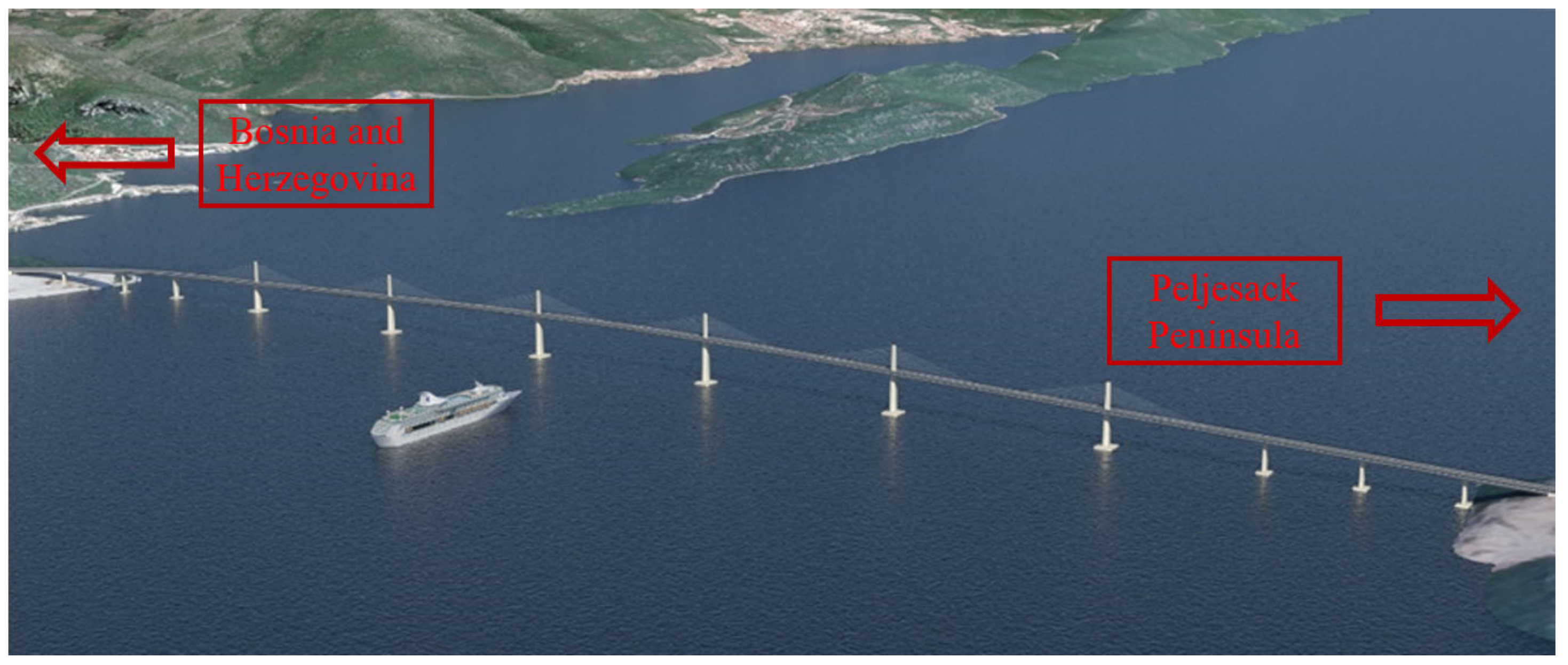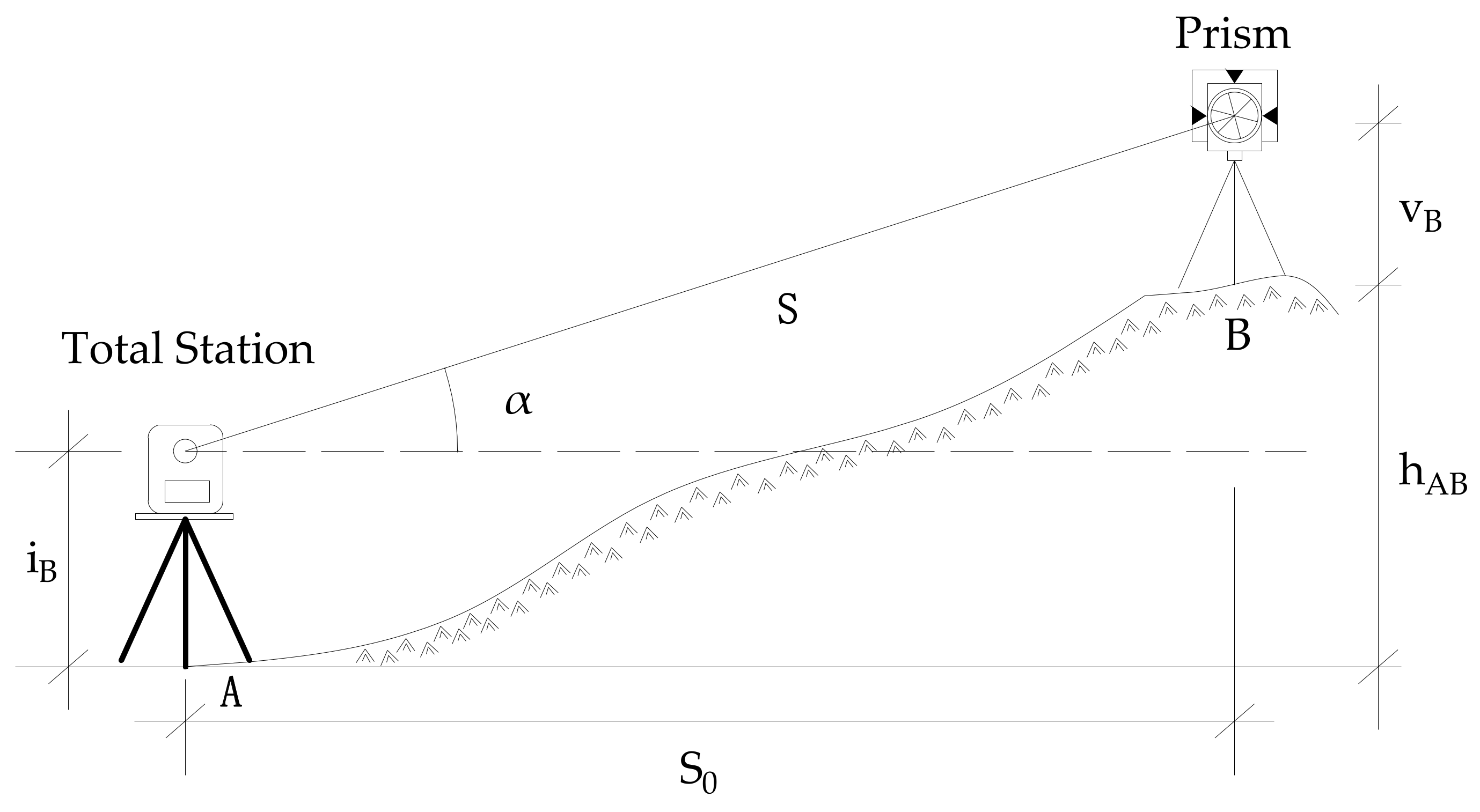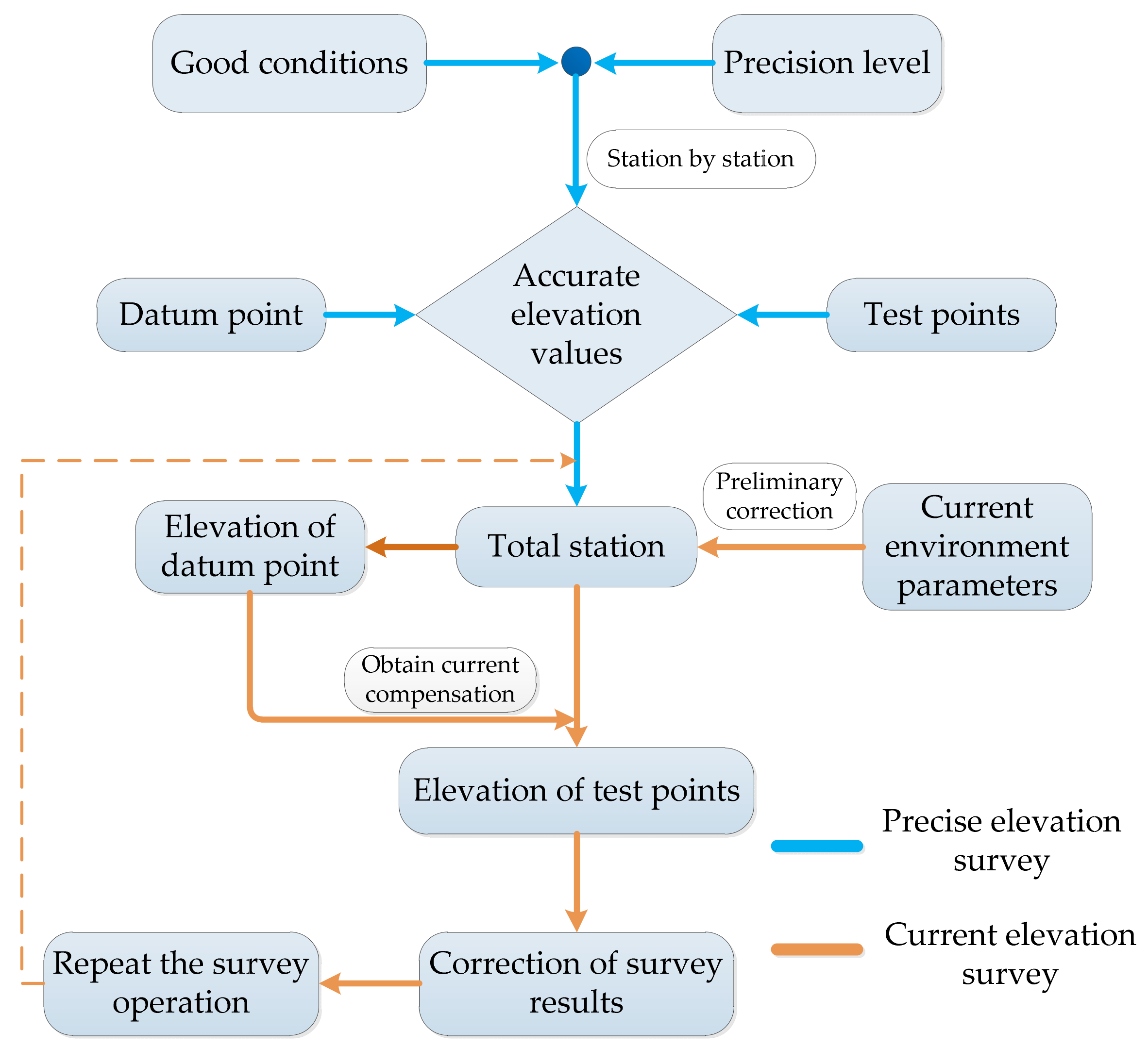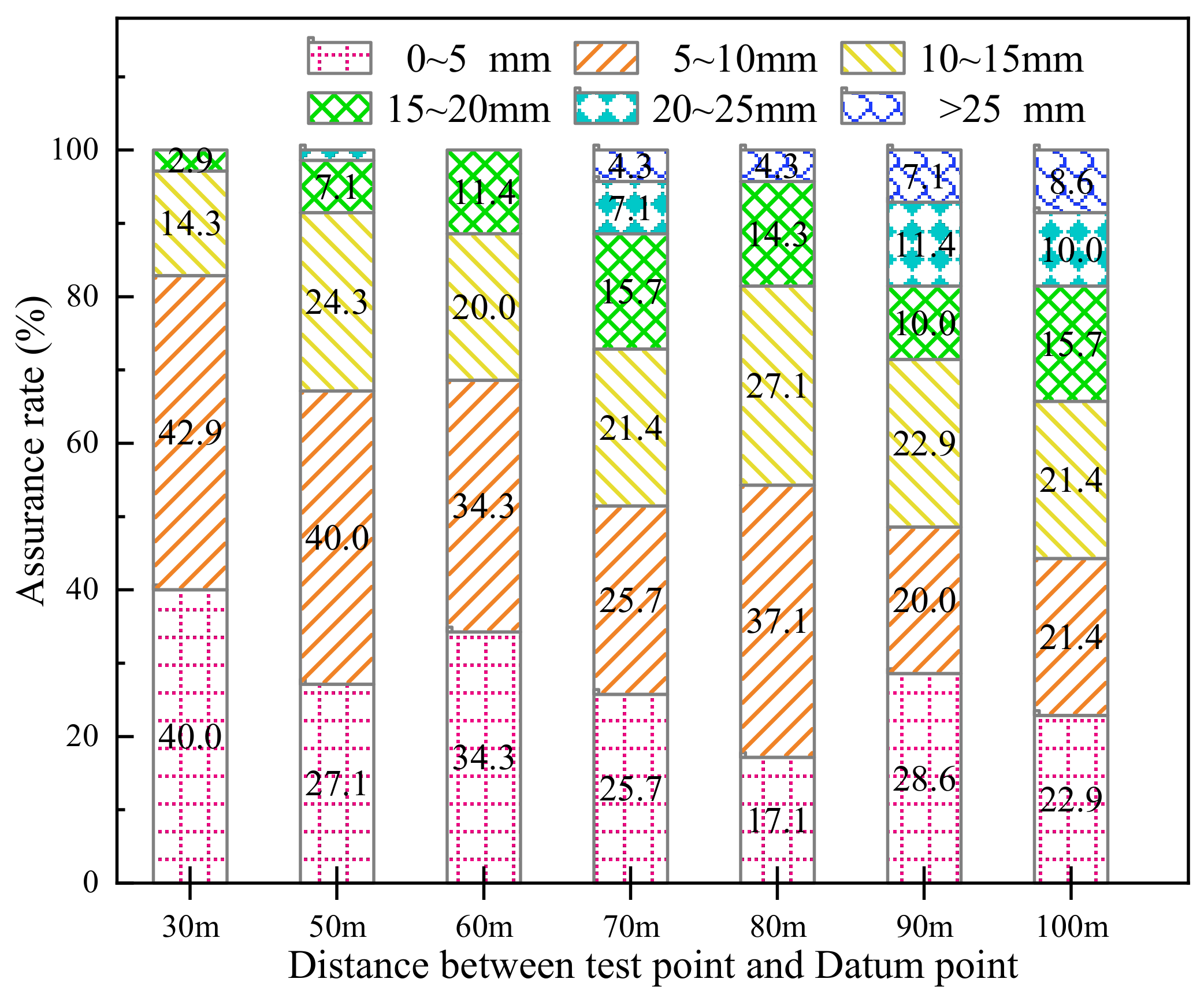Research on Elevation Survey Method of Sea-Crossing Bridge under Adverse Conditions
Abstract
:1. Introduction
2. Principles and Methods
2.1. Engineering Background
2.2. Basic Principle of Total Station Trigonometric Leveling
2.3. Principle of Dynamic Compensation
2.4. Introduction of Experiment
2.4.1. Scheme Design
- (1)
- The distance between the survey station and the datum point should be far enough; there should be no obstructions within the line of sight between the survey station, the datum point, and the test point; and the intervisibility condition should be good.
- (2)
- The survey site should allow the convenient use of the level gauge to transmit the elevation of the survey station to the datum point and the test point station by station;
- (3)
- A certain range around the datum point should be open, which is convenient for the layout of the test points under different conditions.
2.4.2. Experiment Content
- (1)
- In the night or morning with good weather conditions, the elevation of the survey station should be transmitted to the datum point and the test points station by station by using the precision level, and the surveyed elevation values should be drawn up as the accurate elevation values of each point.
- (2)
- During the actual survey, set up a total station at the station, input the current environmental parameters (such as temperature, air pressure, humidity, etc.) into the total station for preliminary correction, and make corresponding records at the same time;
- (3)
- Survey the elevation value of the datum point first, and take the difference between this survey value and the accurate elevation value of the datum point surveyed in step (1) as the correction value of the current survey (errors caused by atmospheric refraction, earth curvature, etc.).
- (4)
- Survey the elevation values of the test points under each working condition in turn, and correct the elevation survey results of each test point by using the correction value in step (2) according to Formula (4) in Section 2.3.
- (5)
- Repeat steps (2), (3), and (4) within a fixed time interval to continuously survey the elevation of the test points.
- In step (1), the accurate elevation values of the datum point and the test points are very important for the correction of the survey results and the evaluation of the experimental results. Therefore, the accuracy of the accurate elevation value survey of each point should be guaranteed.
- As the environmental conditions in a day are changing at all times, the corresponding parameters (temperature, air pressure, humidity, etc.) should be input into the total station for preliminary correction before each data observation.
- To ensure that the survey process is completed under basically the same environmental conditions, the survey results of each group should be completed within two minutes.
2.4.3. Experimental Equipment
3. Results
3.1. Experimental Result
- (1)
- From the uncorrected data results of each test point in each figure, it can be seen that the elevation survey results directly using the total station are greatly affected by the environmental conditions at different times, showing an obvious survey window period. In the early morning with good weather conditions, the light, humidity, temperature, and intervisibility conditions are all within the scope specified in the survey, and the deviation between the survey results and the accurate value is relatively small. Under the ranging condition of about 1000 m, the maximum deviation between the survey result and the accurate value is about 24 mm. With the change in environmental conditions, the deviation between the surveyed results and the accurate value gradually increases.
- (2)
- When the elevation is continuously surveyed in a day, the effect of the continuous change in external environmental conditions on the total station can cause the survey results to shift in a certain direction. Under the experimental conditions described in this paper, the maximum deviation between the elevation survey results and the accurate value can even reach about 25 cm for a test point, and at twilight, when the environmental conditions are relatively mild, the effect of the previous environmental conditions on the total station will continue to affect the elevation survey results. After the survey results are corrected, they can return to the accurate value.
- (3)
- From the variation in the deviation between the survey results of each test point in the figure before and after correction and the accurate value, it can be seen that each test point at different distances from the datum point, after the elevation survey method proposed in this paper is used to correct the elevation survey results at any time, the corrected elevation results can fluctuate within a certain range near the accurate value. At the test point, which is 30 m away from the datum point, the deviation between the corrected survey result and the accurate value can be kept within 20 mm.
- (4)
- Under the same environmental conditions, with the increase in the distance between the test point and the datum point, the fluctuation range of the corrected survey results generally shows a gradually increasing trend. At the test point at a distance of 30 m from the datum point, the maximum deviation between the corrected elevation survey result and the accurate value is 18.0 mm; at the test point at a distance of 100 m from the datum point, the maximum deviation between the corrected elevation survey result and the accurate value is 34.5 mm.


3.2. Data Process
3.2.1. The Accuracy Assurance Rate
- With the increase in the distance between each test point and the datum point, the accuracy assurance rate generally shows a downward trend under the same accuracy requirement.
- By correcting the survey results, within a 30 m horizontal distance from the datum point, the error range of 15 mm can reach a 97.2% assurance rate, and the error range of 20 mm can reach 100% assurance rate; within the transverse distance of 60 m from the datum point, the error range of 20 mm can reach about 90% assurance rate.
- With the increase in the distance between each test point and the datum point, the ratio of different accuracy conditions shows different trends. The ratio of accuracy conditions of 0~5 mm and 5~10 mm shows a decreasing trend. The ratio of 10~15 mm accuracy conditions remains unchanged, while the ratio of greater than 15 mm accuracy conditions shows an upward trend.
3.2.2. Data Dispersion
4. Discussion
5. Conclusions
- (1)
- The analysis shows that the total station elevation survey method based on dynamic compensation proposed in this paper shows a good correction effect on the survey results within 100 m between the test point and the datum point, making the survey results fluctuate within a certain range near the accurate value, which proves that the survey method proposed in this paper is feasible.
- (2)
- The accuracy of the corrected survey results is affected by the distance between the test point and the datum point. Through the correction of the survey results, the assurance rate of 97.2% can be reached in the error range of 15 mm and 100% in the error range of 20 mm within the range of 30 m horizontally from the datum point.
- (3)
- By using this method to correct the survey results and combining it with the built-in ATR technology of the total station to obtain multiple groups of data, and then calculating the mean value, the elevation survey results can reach millimeter-level accuracy within the application range of 100 m from the datum point.
- (4)
- The correction effect of the survey method provided in this paper on the elevation survey results is less affected by the environment. The method of taking the mean value after obtaining multiple groups of data can also be considered a high-precision elevation survey method suitable for harsh environmental conditions.
Author Contributions
Funding
Institutional Review Board Statement
Informed Consent Statement
Data Availability Statement
Conflicts of Interest
References
- Pan, G.R.; Liu, S.T.; Che, J.R.; Fan, W.P.; Zhan, Z.Y. Bridge engineering survey techniques—A case study of Hangzhou Bay Sea-crossing Bridge survey. Bridge Constr. 2009, 1, 33–36. [Google Scholar]
- Zhong, J.; Yang, T.; Pang, Y.T.; Yuan, W.C. A novel structure-pulse coupled model for quantifying the column ductility demand under pulse-like GMs. J. Earthq. Eng. 2021, 1–19. [Google Scholar] [CrossRef]
- Zhong, J.; Ni, M.; Hu, H.M.; Yuan, W.C.; Yuan, H.P.; Pang, Y.T. Uncoupled multivariate power models for estimation performance-based seismic damage states of column curvature ductility. Struct 2022, 36, 752–764. [Google Scholar] [CrossRef]
- Khedmatgozar Dolati, S.S.; Caluk, N.; Mehrabi, A.; Khedmatgozar Dolati, S.S. Non-destructive testing application for steel bridges. Appl. Sci. 2021, 11, 9757. [Google Scholar] [CrossRef]
- Dolati, S.S.K.; Malla, P.; Mehrabi, A.; Polanco, J.O.; Nanni, A. Non-destructive testing applications for in-service FRP reinforced/strengthened concrete bridge elements. In Nondestructive Characterization and Monitoring of Advanced Materials, Aerospace, Civil Infrastructure, and Transportation XVI; SPIE: Bellingham, WA, USA, 2022; pp. 59–74. [Google Scholar]
- Guo, B.J.; Xu, T.D. Leica TCA1800 High-precision ultra-long-distance sea-crossing height leveling. Rail. Investig. Surv. 2007, 1, 1–8. [Google Scholar]
- Wu, D.J.; Xiong, W. Experiment and application of sea-crossing elevation transference based on trigonometric leveling. Sci. Surv. Mapp. 2016, 41, 130–140. [Google Scholar]
- Xiang, F.; Liu, C.L.; Chen, Y.W.; Yang, X.F. Experiment and application of sea-crossing elevation measurement of Lingdingyang Bridge based on change rate of elevation anomaly. Geomat. Spat. Inf. Technol. 2022, 45, 51–54. [Google Scholar]
- Wu, D.J.; Xiong, W. A method of sea-crossing trigonometric leveling by total station in the condition of survey station rocking. Bull. Surv. Mapp. 2016, 6, 87–90. [Google Scholar]
- Yan, B.D.; Zhang, L.C.; Sun, C.J.; Wang, Y.P.; Sun, H.C. Precision analysis and application of trigonometric leveling with total station. Geotech. Eng. Technol. 2021, 35, 351–360. [Google Scholar]
- Wu, D.J.; Xiong, W. An improved method of precise trigonometrical river crossing leveling. Bull. Surv. Mapp. 2010, 3, 4–20. [Google Scholar]
- Yang, Q.; Wang, J.G.; Song, H.X. Using sea-crossing leveling measurement to implement elevation transmission between islands. Hydrogr. Surv. Charting 2018, 38, 75–78. [Google Scholar]
- Xu, Y.M.; Wang, J.G.; Song, H.Y. Application of an improved trigonometrical elevation method in sea-crossing elevation transference. Bull. Surv. Mapp. 2013, S0, 111–123. [Google Scholar]
- Xu, Y.M.; Chen, Y.; Guan, X.; Zhou, J.Y. Approach to minimizing the influence of changeable observational environment on long-distance sea-crossing trigonometric leveling. J. Surv. Eng. 2020, 146, 04020018. [Google Scholar] [CrossRef]
- Zhang, H.J.; Chen, G.H.; Jiang, H.J. Research on the improvement of a long-distance cross-sea triangulation elevation measurement method. Geomat. Spat. Inf. Technol. 2020, 43, 85–94. [Google Scholar]
- Mai, J.K.; Chen, G.H.; Zhou, J.Y.; Zhou, B.Y. Application on extra-long distance and precision cross-sea elevation transfer. Sci. Surv. Mapp. 2021, 46, 59–64. [Google Scholar]
- Wang, Z.P.; Zhou, J.Y.; Chen, G.H.; Dong, B.B.; Huang, R.Z. Data processing and application of super-long-distance cross-sea second-class leveling. Hydrogr. Surv. Charting 2021, 41, 40–48. [Google Scholar]
- Zhang, H.; Hu, B.; Yuan, C.Z. Research and application of precise trigonometric leveling to replace second-class leveling achieving river-crossing leveling. Bull. Surv. Mapp. 2019, 11, 121–125. [Google Scholar]
- Liu, M.B.; Fang, J.C.; Lu, E.F. Calculation method of refraction coefficient based on least square theory. J. East China Univ. Sci. Technol. 2016, 39, 163–165. [Google Scholar]
- Li, J.Z.; Zhang, J.S.; Gao, H.; Liu, Y.; Li, L.P. Application of precise trigonometric leveling to the left and right bank elevation survey of Datengxia Hydro-junction Project. J. Yangtze River Sci. Res. 2022, 39, 160–164. [Google Scholar]
- Li, J.Z.; Liu, Y.; Li, L.P.; Yang, S.M. Application of precise triangulation leveling system in Qinghai area. Beijing Surv. Mapp. 2021, 35, 529–533. [Google Scholar]
- Yang, D.L.; Zou, J.G.; Shen, Y.W.; Zhu, H.B. Research and application of trigonometric leveling to replace precise leveling. J. Surv. Eng. 2021, 147, 04021012. [Google Scholar]
- Tang, Y.J.; Kujawski, E.; Sztubecki, J. Improved leveling approach and its application in civil engineering. J. Surv. Eng. 2018, 144, 06018002. [Google Scholar] [CrossRef]
- Guo, J.Y.; Chen, Y.N.; Liu, X.; Zhong, S.X.; Mai, Z.Q. Route height connection across the sea by using the vertical deflections and ellipsoidal height data. China Ocean Eng. 2013, 27, 99–100. [Google Scholar] [CrossRef]
- Yang, P.B.; Lai, J.F.; Wu, Y.Q. Discussion on high precision elevation transfer method in wide sea of Gangzhu’ao Bridge. Yangtze River 2021, 46, 65–87. [Google Scholar]
- Du, W.J.; Zhang, H.; Jin, S.Y. Research on precise trigonometric leveling instead of second order leveling. Rail. Investig. Surv. 2020, 46, 1–4. [Google Scholar]
- Xu, G.H. A study of EDM precise trigonometric leveling. Bull. Surv. Mapp. 2002, 10, 22–24. [Google Scholar]








| Order | Bridge Name | Span/km | Built/Building |
|---|---|---|---|
| 1 | Hong Kong–Zhuhai–Macao Bridge | 55.0 | Built |
| 2 | Jiaozhou Bay Bridge | 36.5 | Built |
| 3 | Hangzhou Bay Bridge | 36.0 | Built |
| 4 | East Sea Bridge | 32.5 | Built |
| 5 | Quanzhou Bay Bridge | 26.7 | Built |
| 6 | Shenzhen–Zhongshan Bridge | 24.0 | Building |
| 7 | Jintang Bridge | 18.5 | Built |
| 8 | Huangmao Hai Link—Cross-sea section | 14.4 | Building |
| 9 | Jiashao Bridge | 10.1 | Built |
| 10 | Nan’ao Bridge | 9.3 | Built |
| Test Point | Distance from Datum Point L/m | Collimation Mode | Measurement Frequency |
|---|---|---|---|
| DC-30 | 30 | ATR | 1 Group/10 Min |
| DC-50 | 50 | ATR | |
| DC-70 | 70 | ATR | |
| DC-60 | 60 | ATR | |
| DC-80 | 80 | ATR | |
| DC-90 | 90 | ATR | |
| DC-100 | 100 | ATR |
| Test Point | Distance from Datum Point L/m | Corrected Deviation Range/mm | Corrected Deviation Mean/mm | Remarks |
|---|---|---|---|---|
| DC-30 | 30 | −18.0~14.8 | −1.9 | The lowest temperature: is 21 °C; The highest temperature: is 37 °C; The data statistics of each test point: 70 groups. |
| DC-50 | 50 | −19.8~22.0 | −1.0 | |
| DC-70 | 70 | −19.3~19.8 | 0.2 | |
| DC-60 | 60 | −28.7~29.5 | −1.1 | |
| DC-80 | 80 | −34.4~19.1 | −1.5 | |
| DC-90 | 90 | −35.9~27.7 | 0.7 | |
| DC-100 | 100 | −34.5~29.1 | −5.0 |
Publisher’s Note: MDPI stays neutral with regard to jurisdictional claims in published maps and institutional affiliations. |
© 2022 by the authors. Licensee MDPI, Basel, Switzerland. This article is an open access article distributed under the terms and conditions of the Creative Commons Attribution (CC BY) license (https://creativecommons.org/licenses/by/4.0/).
Share and Cite
Xiao, J.; Xian, J.; Li, S.; Zou, S. Research on Elevation Survey Method of Sea-Crossing Bridge under Adverse Conditions. Sustainability 2022, 14, 11641. https://doi.org/10.3390/su141811641
Xiao J, Xian J, Li S, Zou S. Research on Elevation Survey Method of Sea-Crossing Bridge under Adverse Conditions. Sustainability. 2022; 14(18):11641. https://doi.org/10.3390/su141811641
Chicago/Turabian StyleXiao, Jun, Jianping Xian, Song Li, and Shuai Zou. 2022. "Research on Elevation Survey Method of Sea-Crossing Bridge under Adverse Conditions" Sustainability 14, no. 18: 11641. https://doi.org/10.3390/su141811641
APA StyleXiao, J., Xian, J., Li, S., & Zou, S. (2022). Research on Elevation Survey Method of Sea-Crossing Bridge under Adverse Conditions. Sustainability, 14(18), 11641. https://doi.org/10.3390/su141811641









